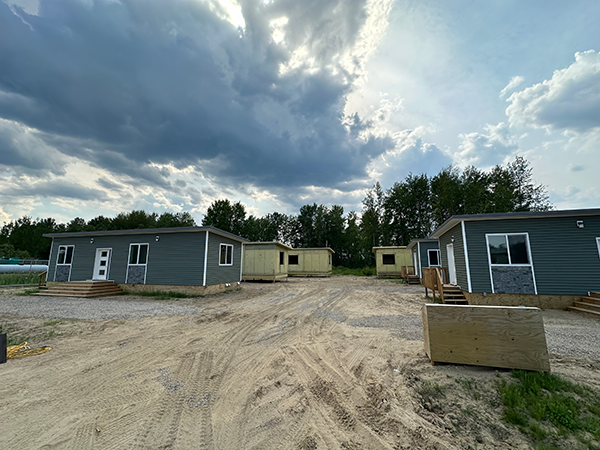Alberta-based Ecoplast Solutions is building net-zero-ready emission housing using structural insulated panels (SIP) made from recycled plastic beverage bottles turned into a high-efficiency, closed-cell foam.
“We need to build better – not just more,” said managing partner Kelly Rogers, as the five-year-old prefabricated company is forward-looking to Canada’s housing demand that all new housing be net-zero ready by 2030.
Rogers said the company remains focused on the housing market because of the acute need for housing but also the growing concern climate change is demanding housing meet higher efficiency standards.
“We are focused on energy efficiency and recycling material or alternate building materials,” said Rogers, a focus that sets the company apart from other prefab manufacturers or conventional builders he believes. “We can’t be a traditional builder.”
The SIP panels with the plastic foam core have many attributes, he said.
“The major benefits are the high strength-to-weight ratio,” he said with wind tunnel testing up to 326 miles per hour or twice the strength of a Category 5 hurricane. “It doesn’t degrade over time and the panels don’t lose their R-30 effectiveness. There are no thermal bridges because there are no studs.”

Compared to conventional construction, there is a 50 per cent cost saving in heating and cooling. As well, the composite material made from bottles is not subject to mould or water damage.
There is also the waste-reduction aspect. Each square foot of foam is made from 192 recycled beverage plastic bottles, of which there is no shortage. The company estimates it has utilized 15 million bottles in home construction.
“This is not new technology,” said Rogers.
Companies have been turning beverage bottles plastic or PET (polyethylene terephthalate) closed cell foam and closed cell foam has been used extensively in the boat building industry because of its resistance to water.
What’s new is that in 2018, an Ecoplast affiliate company JD Composites in Nova Scotia, moved the concept into the home construction industry when it began sourcing the recycled bottle foam into a patented SIP with a fibre-glass skin to use in home, light industrial and commercial applications.
Ecoplast Solutions was born two years later 2020 in Lloydminster using the technology, with Rogers and co-founder Jean-Marc d’Entremont.
It was focused on the western Canadian market.
“We started in the middle of COVID, so it was a slow start for us,” said Rogers, as the company carried on the R&D to move into high-performance housing. The first year it took what business it could to get the product known, even building a few ice-fishing shacks.
Since then sales have climbed, Rogers said. It has three markets: custom homes, First Nations (FN) homes and multiple unit residential buildings (MURBs). Rogers projects sales will grow in 2025 by a minimum of 50 per cent and as much as 100 per cent.
As well as the green and energy efficiency attributes the SIPs bring, Ecoplast – like other prefabricators – offers expediency. It has its own manufacturing facility and works with clients and architects to turn concept into design. Verification is done by a third-party engineer.
The company’s first custom-built, two-storey, 1,500-square-foot home took only 17 hours to assemble onsite. Generally, Rogers said, a home is assembled over a two-day period.
“When we build it here, we can do it even faster,” he said, as the company can truck the finished product to site where foundations can range from a traditional concrete foundation to piling (in flood areas) and can also include an in-ground basement.
The company, located near the Alberta and Saskatchewan border, found there was an acute need for FN housing in the area, where as much as 40 per cent of homes needed repairs and suffer from mould and overcrowding, he said.
“Mould is an issue and that is something that the panels are able to address,” he said.
As well as the plastic core and skins, the panels have air and vapour barriers and, on the outside, exterior cladding can be attached including fire resistant material. On the interior side of the panel there are provisions for plumbing and electrical before the final drywall is applied.
Ecoplast can finish the exterior and interior but if there are FN tradesmen, Ecoplast will work with them, he said.
The company is also building MURBs, but they are limited to two-storey structures. The panels are the structural components, he said, and going to higher levels would require a different design with structural components such as beams.
Rogers said there is a perception that building a prefab, net-zero ready home is more expensive. It’s not.
“If you compare us to other net-zero homes, we are cheaper,” he said, adding when compared to a regular prefab home, the price is competition “but with twice the performance.”
Rogers said home construction is going through a transition.
“Everything is shifting,” he said, as the industry pushes toward higher performance levels, more prefabrication and a focus on green building.
“We are right where the industry is pushing,” he said.




Recent Comments
comments for this post are closed